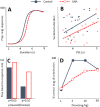The instrumental role of operant paradigms in translational psychiatric research: Insights from a maternal immune activation model of schizophrenia risk
- PMID: 35319781
- PMCID: PMC9314699
- DOI: 10.1002/jeab.753
The instrumental role of operant paradigms in translational psychiatric research: Insights from a maternal immune activation model of schizophrenia risk
Abstract
Rigorous behavioral analysis is essential to the translation of research conducted using animal models of neuropsychiatric disease. Here we discuss the use of operant paradigms within our lab as a powerful approach for exploring the biobehavioral bases of disease in the maternal immune activation rat model of schizophrenia. We have investigated a range of disease features in schizophrenia including abnormal perception of time, cognition, learning, motivation, and internal state (psychosis), providing complex insights into brain and behavior. Beyond simple phenotyping, implementing sophisticated operant procedures has been effective in delineating aspects of pathological behavior, identifying interacting pathologies, and isolating contributing mechanisms of disease. We provide comment on the strengths of operant techniques to support high-quality behavioral investigations in fundamental neuropsychiatric research.
Keywords: animal model; maternal immune activation; operant; rat; schizophrenia.
© 2022 The Authors. Journal of the Experimental Analysis of Behavior published by Wiley Periodicals LLC on behalf of Society for the Experimental Analysis of Behavior.
Figures



Similar articles
-
Translational Rodent Paradigms to Investigate Neuromechanisms Underlying Behaviors Relevant to Amotivation and Altered Reward Processing in Schizophrenia.Schizophr Bull. 2015 Sep;41(5):1024-34. doi: 10.1093/schbul/sbv093. Epub 2015 Jul 20. Schizophr Bull. 2015. PMID: 26194891 Free PMC article. Review.
-
Selective breeding for deficient sensorimotor gating is accompanied by increased perseveration in rats.Neuroscience. 2007 Sep 7;148(3):612-22. doi: 10.1016/j.neuroscience.2007.06.034. Epub 2007 Aug 10. Neuroscience. 2007. PMID: 17693035
-
Complexities and paradoxes in understanding the role of dopamine in incentive motivation and instrumental action: Exertion of effort vs. anhedonia.Brain Res Bull. 2022 May;182:57-66. doi: 10.1016/j.brainresbull.2022.01.019. Epub 2022 Feb 10. Brain Res Bull. 2022. PMID: 35151797 Review.
-
Cognitive and arginine metabolic correlates of temporal dysfunction in the MIA rat model of schizophrenia risk.Behav Neurosci. 2023 Feb;137(1):67-77. doi: 10.1037/bne0000540. Epub 2022 Oct 31. Behav Neurosci. 2023. PMID: 36315619
-
Effects of neonatal excitotoxic lesions of the entorhinal cortex on cognitive functions in the adult rat.Neuroscience. 2004;128(2):365-74. doi: 10.1016/j.neuroscience.2004.07.011. Neuroscience. 2004. PMID: 15350648
References
-
- Abazyan, B. , Nomura, J. , Kannan, G. , Ishizuka, K. , Tamashiro, K. L. , Nucifora, F. , Pogorelov, V. , Ladenheim, B. , Yang, C. , Krasnova, I. N. , Cadet, J. L. , Pardo, C. , Mori, S. , Kamiya, A. , Vogel, M. W. , Sawa, A. , Ross, C. A. , & Pletnikov, M. V. (2010). Prenatal interaction of mutant DISC1 and immune activation produces adult psychopathology. Biological Psychiatry, 68, 1172–1181. 10.1016/j.biopsych.2010.09.022 - DOI - PMC - PubMed
-
- Alústiza, I. , Radua, J. , Pla, M. , Martin, R. , & Ortuño, F. (2017). Meta‐analysis of functional magnetic resonance imaging studies of timing and cognitive control in schizophrenia and bipolar disorder: Evidence of a primary time deficit. Schizophrenia Research, 188, 21–32. 10.1016/j.schres.2017.01.039 - DOI - PubMed
Publication types
MeSH terms
LinkOut - more resources
Full Text Sources
Medical
Miscellaneous

